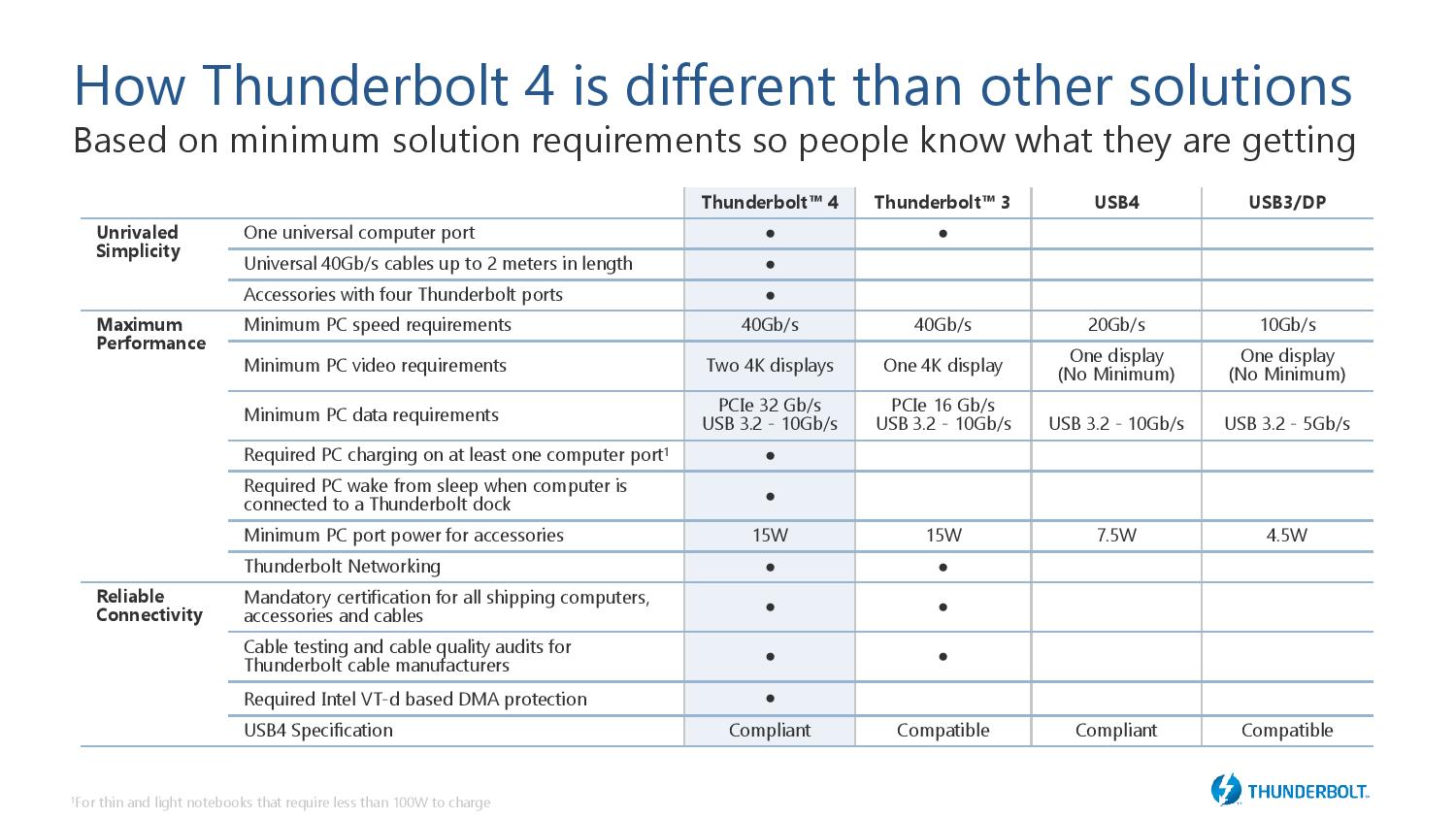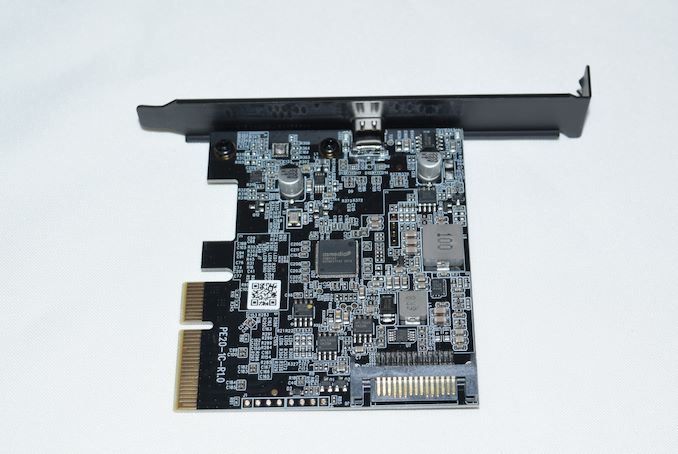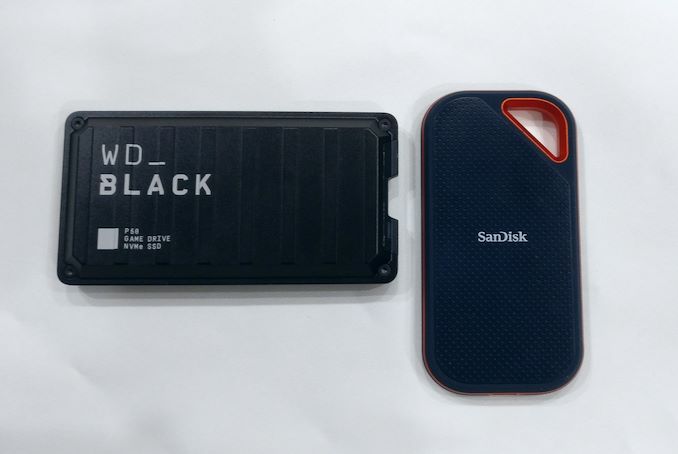USB 3.2 Gen 2x2 State of the Ecosystem Review: Where Does 20Gbps USB Stand in 2020?
by Ganesh T S on October 5, 2020 10:30 AM EST- Posted in
- Storage
- SSDs
- Western Digital
- SanDisk
- ASMedia
- USB 3.2 Gen 2x2
Miscellaneous Aspects and Concluding Remarks
In the preceding sections, we discussed our efforts to equip legacy systems with USB 3.2 Gen2x2 support. We also looked at two devices capable of taking advantage of the speed benefits offered by the 2x2 standard - the WD_BLACK P50, and the SanDisk Extreme PRO Portable SSD v2. Both of them live up to their advertised performance numbers - double that of the best-performing USB 3.2 Gen 2 NVMe SSDs. Does that make it a no-brainer to go out and purchase them if top performance is what one is after? Prior to discussing that, a short discussion of USB 3.2 Gen 2x2 in the context of the evolution of USB standards is in order.
USB 3.2 Gen 2x2 - An Orphaned Standard?
The diagram below shows the evolution of the USB standards, with different versions, suggested consumer branding names, and maximum supported data rates. Despite the best efforts of USB-IF, the sad truth is that most consumers identify ports and devices according to the version of the standard, rather than the branding.
One of the appreciable things about USB is that it has historically maintained backwards compatibility both in terms of features and performance. As we look at USB 3.2 Gen 2x2 and the USB4 standards, we find that USB-IF still claims backwards compatibility, but the implicitly inferred performance aspect is being dropped. Allow us to explain with an example.
Take a time, for example, when USB 3.0 (later rechristened as USB 3.2 Gen 1) was just about getting introduced. We assume the purchase of an external SSD like the OCZ Enyo at that time in the rest of this example. With the introduction of USB 3.1 (now called USB 3.2 Gen 2) a few years later, the Enyo SSD would still be expected to operate at its advertised 5 Gbps speed. How would one react if USB 3.1 ports happened to yield only 480 Mbps performance for the Enyo SSD? Sounds preposterous? Well, that is what is happening right in front of our eyes with the current transition to USB4!
USB4 hosts and devices will be marketed to consumers as USB4 20Gbps or USB4 40Gbps, depending on the maximum speed they support. One would think that is great, as USB 3.2 Gen 2x2 devices are rated at 20Gbps. This would easily fit into the lower USB4 tier. Unfortunately, therein lies the fine-print:
- Both USB4 20Gbps and USB4 40Gbps are mandated to support only up to USB 3.2 Gen 2 speeds - that is 10 Gbps. Vendors can optionally support higher, but the minimum needed for certification is 10 Gbps.
- The other 10Gbps needed to meet the minimum speed requirements (20 Gbps for the lower USB4 tier) can come from an optional display output.
This means that USB 3.2 Gen 2x2 devices - capable of operating at up to 20 Gbps like the SSDs we discussed in this review - will operate at Gen 2 speeds (10 Gbps) in those USB4 ports that only fulfil the minimum mandated USB 3.2 data speed. In fact, it is confirmed that even the USB4 40Gbps and Thunderbolt 4 ports (that are compliant with USB4 specifications) of the Tiger Lake UP3-based systems will operate these 20 Gbps SSDs only at 10 Gbps.

The decision to not mandate performance backwards compatibility by USB-IF is bound to cause consumer angst. Essentially, USB-IF can claim that USB 3.2 Gen 2x2 is a parallel standard, but not mandatorily including its capabilities as part of USB4 makes it seem like an orphan one.
Pricing
USB 3.2 Gen 2x2 support is natively available in some premium motherboards. These mostly include specific TRX40, Z490, and X299 boards. PC users who aren't planning on building a new system have to rely on add-in cards. The one used in the review today, the Yottamaster C5, is available for $70. There are other options such as the Orico PE20-1C for $50, and the Ableconn PEX-UB159 for $60. All three use the same ASMedia ASM3242 controller. In fact, the Orico card and the Yottamaster C5 seem to be clones of each other, except for the branding on the bracket. The former is also discounted by $10 on Newegg if slow international shipping is not a concern.
| External Flash Storage Devices - Pricing | ||||
| Product | Model Number | Capacity (GB) | Street Price (USD) | Price per GB (USD/GB) |
| SanDisk Extreme PRO Portable SSD v2 2TB | SDSSDE81-2T00 | 2000 | $380 | 0.19 |
| Western Digital WD_BLACK P50 1TB | WDBA3S0010BBK | 1000 | $229 | 0.229 |
| SanDisk Extreme Portable SSD v2 1TB | SDSSDE61-1T00 | 1000 | $240 | 0.24 |
The USB 3.2 Gen 2x2 SSDs carry a price premium - either by forcing the purchase of a high-capacity drive, or, not delivering on a reasonable cost per GB metric for the lower capacity points. The USB SuperSpeed 10Gbps candidate above - the Extreme Portable SSD v2 - is a new product with a manufacturer suggested retail price of $200 (with street prices expected to be much lower). A more reasonable comparison point would be the WD My Passport SSD at $170 (for $0.17 per GB).
USB4 20Gbps and USB4 40Gbps-certified hosts are NOT mandated to support the 2x2 mode - They can still call themselves USB4 40 Gbps or even Thunderbolt 4, and the 2GBps+ devices that we saw in today's review will operate only in Gen 2 mode (10 Gbps). Similar speeds can be obtained across a wider variety of systems with external SSDs that are much cheaper like the SanDisk PRO Extreme Portable SSD v1 or the WD My Passport SSD.
Final Words
Currently available USB 3.2 Gen 2x2 hosts and devices use silicon from one supplier - ASMedia. JMicron had previously talked in various trade shows about the JMS586 USB 3.2 Gen 2x2 to PCIe 3.0 x4 SSD bridge controller and the JMS591 USB 3.2 Gen 2x2 / eSATA III to 5-port SATA III bridge controller. When retail products using those controllers start hitting the market, the pricing premium that ASMedia commands may temper a bit.
On the ecosystem side, we have seen many PCIe cards with a single USB 3.2 Gen 2x2 port being announced over the last year or so. All of them have been based on the ASMedia ASM3242 controller. Unfortunately, very few have made it to the retail market. Based on our experience with the Yottamaster C5 outlined in the 'Testbed Travails' section, and the online reviews associated with the few available cards), it is not difficult to see why - motherboard compatibility / stability is a hit or a miss. Under such conditions, reputed brands tend to reduce the distribution quantity. Some even just do a paper launch and sweep the product under the rug discreetly. The other plausible explanation is that the card vendors are waiting for the 2x2 ecosystem to develop further before widening market distribution - that hits a snag with the upcoming set of USB4 hosts which do not support the 2x2 features. In either case, trying to add USB 3.2 Gen 2x2 support to legacy systems is a difficult exercise which might prove frustrating for the average PC builder.
The WD_BLACK P50 SSD fulfills its promise, but the minor blip is the write performance consistency under extreme stress. In the 1TB sample, the drop happens after 600GB+ of continuous writes - Other than, say, transferring a huge Steam library from one device to another, this type of workload is not going to be common for the P50. The P50 is also geared towards gaming workloads, as evident from its performance for gaming load times compared to its performance for other types of workloads. Another aspect that we found strange about the P50 was its behavior with Type-C to Type-A cables - even the ones supplied with the unit. We found one orientation of the Type-C cable would make it operate at USB 2.0 speeds, while reversing the orientation would sometimes make it operate at around 250 MBps and sometimes at USB 2.0 speeds. We had no such issues with the SanDisk Extreme PRO Portable SSD v2.
Like the SanDisk Extreme PRO Portable SSD from 2019, the SanDisk Extreme PRO Portable SSD v2 leaves very little to complain about. On the performance and consistency side, the drive has no competition. The workloads it might be subject to by content creators need the device to operate without throttling even under conditions like the one making the P50 throttle - and we were able to see that it doesn't. The casing does get hot under this type of workload, but not under normal usage like transferring, say, 20 - 30 GB of multimedia files of various sizes in one go. The only thing we do not like about the device is the pricing and possibilities of future compatibility. In our opinion, Western Digital should just release a Thunderbolt 3-capable SanDisk Extreme PRO variant to put the concerns below to rest. The company, however, expects rapid adoption of USB 3.2 Gen 2x2 next year. Without that future visibility, we can only make recommendations on the basis of the current state of the ecosystem - a wait and watch approach is warranted.
Thunderbolt 3 drives could turn out to be a better choice compared to the USB 3.2 Gen 2x2 ones if future USB4 ports are going to be relied upon to enable the advertised high speeds. It is again a game of chance, because the PCIe tunneling support is optional in USB4. That said, the USB4 ports of Tiger Lake systems will obviously support Thunderbolt 3 drives at their maximum speeds. Due to the premium associated with the Gen 2x2 drives reviewed today, we can only recommend them for niche use-cases. In particular, if it is known in advance that the systems the drive is going to be frequently used with support USB 3.2 Gen 2x2, it is a perfectly acceptable alternative to Thunderbolt 3 drives.













81 Comments
View All Comments
Eric_WVGG - Tuesday, October 6, 2020 - link
On a related note, I would love to see you guys do some kind of investigation into why we're five years into this standard and one still cannot buy an actual USB-C hub (i.e. not a port replicator).hubick - Tuesday, October 6, 2020 - link
A 3.2 hub with gen 2 ports and a 2x2 uplink would be cool!I wanted a 10gbps / gen 2 hub and got the StarTech HB31C3A1CS, which at least has a USB-C gen 2 uplink and a single USB-C gen 2 port (plus type A ports). Don't know if you can do any better than that right now.
repoman27 - Tuesday, October 6, 2020 - link
Although it's still not exactly what you're looking for, I've tried (unsuccessfully) to get people to understand what a unicorn the IOGEAR GUH3C22P is. Link: https://www.iogear.com/product/GUH3C22PIt's a 5-port USB3 10Gbps hub with a tethered USB Type-C cable on the UFP (which supports up to 85W USB PD source), two (2!) downstream facing USB Type-C ports (one of which supports up to 100W USB PD sink), and two USB Type-A ports (one of which supports up to 7.5W USB BC).
serendip - Thursday, October 8, 2020 - link
No alt mode support like for DisplayPort. I haven't found a portable type-C hub that supports DisplayPort alt mode over downstream type-C ports although some desktop docks support it.stephenbrooks - Tuesday, October 6, 2020 - link
What if I want a USB 20Gbps port on the front of my computer?Can I get a USB-C front panel and somehow connect the cable internally to the PCI-E USB card?
abufrejoval - Tuesday, October 6, 2020 - link
I am building hyperconvergent clusters for fun and for work, the home-lab one out of silent/passive 32GB RAM, 1TB SATA-SSD J5005 Atoms, the next iteration most likely from 15Watt-TDP-NUCs, an i7-10700U with 64GB RAM, 1TB NVMe SSD in testing.Clusters need short-latency, high-bandwidth interconnects, Infiniband is a classic in data centers, but NUCs offer 1Gbit Ethernet pretty much exclusively, Intel struggling to do 2.5Gbit there while Thunderbolt and USB3/4 could do much better. Only they aren’t peer-to-peer and a TB 10Gbase-T adapter sets you back further than the NUC itself, while adding lots of latency and TCP/IP, while I want RDMA.
So could we please pause for a moment and think on how we can build fabrics out of USB-X? Thunderbolt/USB4 is already about PCIe lanes, but most likely with multi-root excluded to maintain market segmentation and reduce validation effort.
I hate how the industry keeps going to 90% of something really useful and then concentrating on 200% speed instead of creating real value.
repoman27 - Wednesday, October 7, 2020 - link
Uh, Thunderbolt and USB4 are explicitly designed to support host-to-host communications already. OS / software support can be a limiting factor, but the hardware is built for it.Existing off-the-shelf solutions:
https://www.dataonstorage.com/products-solutions/k...
https://www.gosymply.com/symplyworkspace
https://www.areca.com.tw/products/thunderbolt-8050...
http://www.accusys.com.tw/T-Share/
IP over Thunderbolt is also available:
https://thunderbolttechnology.net/sites/default/fi...™%20Networking%20Bridging%20and%20Routing%20Instructional%20White%20Paper.pdf
https://support.apple.com/guide/mac-help/ip-thunde...
repoman27 - Wednesday, October 7, 2020 - link
Stupid Intel URL with ™ symbol. Let's try that again:https://thunderbolttechnology.net/sites/default/fi...
abufrejoval - Wednesday, October 7, 2020 - link
Let me tell you: You just made my day! Or more likely one or two week-ends!Not being a Mac guy, I had completely ignored Thunderbolt for a long time and never learned that it supported networking natively. From the Intel docs it looks a bit similar to Mellanox VPI and host-chaining: I can use 100Gbit links there without any switch to link three machines in a kind of “token ring” manner for Ethernet (these are hybrid adapters that would also support Infiniband, but drivers support is only support Ethernet for host-chaining). Unfortunately the effective bandwidth is only around 35GByte/s for direct hops and slows to 16GByte/s once it has to pass through another host: Not as much of an upgrade over 10Gbase-T as you’d hope for: I never really got into testing latencies, which is where the Infiniband personality of those adapters should shine.
And that’s where with TB I am hoping for significant improvements over Ethernet apart from native 40Gbit/s speed: Just right for Gluster storage!
I also used to try to get Ethernet over fiber-channel working years ago, when they were throwing out 4Gbit adapters in the data center, but even if it was specified as a standard, Ethernet over fiber never got driver support and at the higher speeds the trend went the other direction.
So I’ll definitely try to make the direct connection over TB3 work: CentOS8 should have kernel support for TB networking and the best news is that it doesn’t have to wait for TB4, but should work with TB3, too.
I’ve just seen what seemed like an incredibly cheap 4-way TB switch recommended by Anton Shilov on the TomsHardware side of this enterprise, which unfortunately is only on pre-order for now (https://eshop.macsales.com/shop/owc-thunderbolt-hu... but supposed to support TB networking. Since the NUCs are single port TB3 only, that should still do the trick and be upgradable to TB4 for just around $150… The 5Gbit USB3 Aquantia NIC wasn’t much cheaper and even the 2.5Gbit USB3 NIC are still around $40.
Exciting, exciting all that: Thank you very much for those links!
abufrejoval - Wednesday, October 7, 2020 - link
...except... I don't think that "switch" will be supporting multiple masters, same as USB.If it did, Intel would have shot themselves in the foot: 40Gbit networking on NUCs and laptops with little more than passive ables, that's almost as bad as adding a system management mode on 80486L and finding that it can be abused to implement a hypervisor (Mendel and Diane started VMware with that trick).
Yet that's exactly what consumers really thirst for.